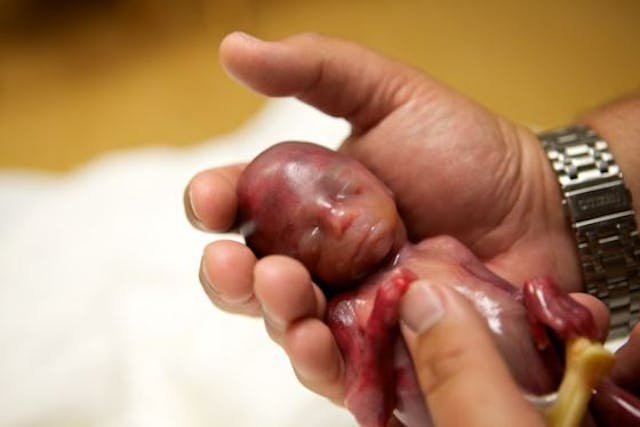
Medical staff fired for discharging woman in labor, who then gave birth in truck
Cassy Cooke
·
Killing second-trimester preborn babies to be presented as ‘inspiring’ at State of the Union
Set to attend the State of the Union on Thursday is Kate Cox, upon the invitation of First Lady Jill Biden. Cox sued the state of Texas for the right to kill her preborn child who was diagnosed with Trisomy 18 — a genetic condition that is considered “life-limiting” but not fatal. She lost that legal challenge and ultimately had a D&E dismemberment abortion in New Mexico. Austin Dennard will reportedly also be present; she starred in a Biden campaign ad, and aborted a child with anencephaly.
Also set to attend upon the invitation of U.S. Senator Patty Murray (D-Wash.) is Kayla Smith, a woman who traveled from Idaho to Washington to have a second-trimester abortion in 2022. Murray believes Smith has an “inspiring” story because of her determination to end her son’s life by abortion.
Notably not invited to the State of the Union on Thursday are women who chose life for their babies after receiving a prenatal diagnosis, including Elisabeth Scott, whose daughter Brianna is four years old with Trisomy 18, and Alyse Schwartz-Mosca, whose son Ellis underwent heart surgery. These are the women who, when faced with a prenatal diagnosis, acted heroically to fight for the equal dignity and treatment of their children.
Operable or inoperable?
In Kayla Smith’s case, she was expecting her second child with her husband James when they learned at a routine ultrasound at 18-20 weeks that their preborn son, Brooks, had two heart defects. The diagnosis came just two days after Idaho’s pro-life trigger law took effect. It is unclear if Brooks had additional diagnoses, though KTVB reported he had “several fetal anomalies, including serious heart defects.” James told KTVB, “Based on what they were saying, it wasn’t going to be operable. So told it’s not operable, no choice is easy going forward.”
But the two heart conditions the Smiths’ son had — based on those listed by Murray — are described as operable.
Murray claimed Brooks had critical aortic stenosis (CAS) and hypoplastic left heart syndrome (HLHS). According to The Mayo Clinic, “Children with hypoplastic left heart syndrome will likely need several surgeries. … The procedures are done in three stages.” Live Action News recently reported on two young men, Seth and Tate, who were born with HLHS and are now successful college students with promising futures.

As for CAS, according to the National Institutes of Health, “Among Symptomatic patients, the guidelines recommend aortic valve intervention prior to major non-cardiac surgery because of …. improved rates of long-term overall success.” According to Johns Hopkins, in cases of congenital CAS, what’s known as the Ross procedure, can be carried out, in which the surgeon removes the abnormal aortic valve and replaces it with the child’s pulmonary valve. A donor valve is used to replace the pulmonary valve.”
But this is not the only treatment option. Johns Hopkins reports that CAS is often present with other types of heart defects (as in Brooks’ case) but, “Most children do well with the Ross procedure.”
Ellis Schwartz-Mosca also had aortic stenosis. Live Action News shared his story recently, explaining that in 2019, Ellis was diagnosed at 20 weeks via ultrasound and underwent heart surgery at just a few days old. He became the recipient of the world’s smallest mechanical heart valve. Until a few years ago, that tiny valve hadn’t even been developed yet. “He’s doing amazing. He’s chatty all the time,” said Ellis’s mother, Alyse.
Willing to take the risk for a healthy baby?
Regardless of the available treatments, the Smiths moved forward with an abortion ultimately because, in addition to Brooks’ diagnoses, Smith had previously developed preeclampsia during her first pregnancy with their daughter, and was worried she might develop it a second time. However, that concern always existed —even when she believed Brooks to be “healthy.”
Article continues below
Dear Reader,
Have you ever wanted to share the miracle of human development with little ones? Live Action is proud to present the "Baby Olivia" board book, which presents the content of Live Action's "Baby Olivia" fetal development video in a fun, new format. It's perfect for helping little minds understand the complex and beautiful process of human development in the womb.
Receive our brand new Baby Olivia board book when you give a one-time gift of $30 or more (or begin a new monthly gift of $15 or more) to fuel Live Action’s life-saving content.
It was only after his diagnosis that she ultimately decided the risk of possibly developing preeclampsia was not worth her son’s life.
At 21 weeks, the youngest age at which children have survived preterm birth, the couple traveled (and eventually moved) from Idaho, where most preborn children are protected from abortion, to neighboring Washington state for an induction abortion. They claim they were “forced” to do so by Idaho’s pro-life law. Logic would dictate that no one was forced to kill a yet-living child.
During an induction abortion, a feticide is injected into the heart or head of the preborn child and he is then delivered prematurely. If he manages to survive the feticide, to ensure he does not survive long after birth, he may be denied medical care at the parents’ request — despite the fact that this is technically illegal. The goal of the induction abortion was to ensure Brooks did not survive.

Murray is now celebrating Brooks’ death by lethal injection in the name of pro-abortion propaganda. She called his murder “care [his parents] were barred from obtaining in Idaho” and said the “anti-abortion agenda” is akin to “cruelty,” which results in “horrific consequences.” Those consequences are that children — even those with disabilities — are not able to be killed in the womb. Yet, Murray called the Smiths’ efforts to prematurely end Brooks’ life “inspiring.”
The goal isn’t really clarification
Kayla and James Smith went on to have a second daughter and Smith is now a plaintiff in the Adkins v. State of Idaho case challenging Idaho’s pro-life law. The suit was filed by the Center for Reproductive Rights in September.
While plaintiffs claim they want the exceptions of the law to be clarified and expanded to include allowing the abortions of children who receive a fatal fetal diagnosis or in cases in which the mother’s health and safety are said to be compromised, the end goal of the lawsuit is to ensure abortion is available in Idaho through all nine months of pregnancy. If unnecessary medical exceptions are included in the pro-life law, there will be nothing left to protect the children being targeted for abortion late in pregnancy.
Induced abortion — the direct and intentional killing of a preborn child — is not medically necessary. If Smith had truly been worried about the development of preeclampsia, she could have been carefully monitored for the condition and then had Brooks delivered if her health did indeed become compromised — as she did with her firstborn daughter.
Live Action News is pro-life news and commentary from a pro-life perspective.
Contact editor@liveaction.org for questions, corrections, or if you are seeking permission to reprint any Live Action News content.
Guest Articles: To submit a guest article to Live Action News, email editor@liveaction.org with an attached Word document of 800-1000 words. Please also attach any photos relevant to your submission if applicable. If your submission is accepted for publication, you will be notified within three weeks. Guest articles are not compensated (see our Open License Agreement). Thank you for your interest in Live Action News!

Cassy Cooke
·
Abortion Pill
Nancy Flanders
·
Politics
Nancy Flanders
·
Human Rights
Nancy Flanders
·
Politics
Nancy Flanders
·
Politics
Sheena Rodriguez
·
Abortion Pill
Nancy Flanders
·
Politics
Nancy Flanders
·
International
Nancy Flanders
·
Human Interest
Nancy Flanders
·
Human Rights
Nancy Flanders
·